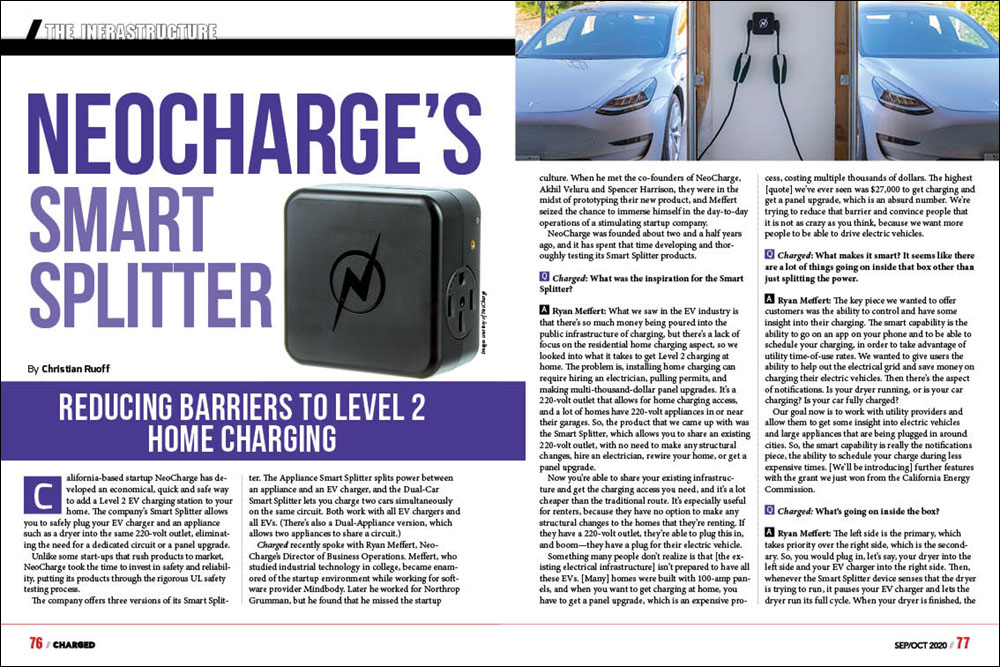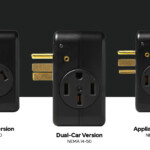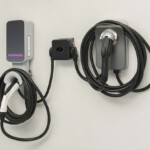California-based startup NeoCharge has developed an economical, quick and safe way to add a Level 2 EV charging station to your home. The company’s Smart Splitter allows you to safely plug your EV charger and an appliance such as a dryer into the same 220-volt outlet, eliminating the need for a dedicated circuit or a panel upgrade.
Unlike some start-ups that rush products to market, NeoCharge took the time to invest in safety and reliability, putting its products through the rigorous UL safety testing process.
The company offers three versions of its Smart Splitter. The Appliance Smart Splitter splits power between an appliance and an EV charger, and the Dual-Car Smart Splitter lets you charge two cars simultaneously on the same circuit. Both work with all EV chargers and all EVs. (There’s also a Dual-Appliance version, which allows two appliances to share a circuit.)
Charged recently spoke with Ryan Meffert, NeoCharge’s Director of Business Operations. Meffert, who studied industrial technology in college, became enamored of the startup environment while working for software provider Mindbody. Later he worked for Northrop Grumman, but he found that he missed the startup culture. When he met the co-founders of NeoCharge, Akhil Veluru and Spencer Harrison, they were in the midst of prototyping their new product, and Meffert seized the chance to immerse himself in the day-to-day operations of a stimulating startup company.
NeoCharge was founded about two and a half years ago, and it has spent that time developing and thoroughly testing its Smart Splitter products.
Charged: What was the inspiration for the Smart Splitter?
Ryan Meffert: What we saw in the EV industry is that there’s so much money being poured into the public infrastructure of charging, but there’s a lack of focus on the residential home charging aspect, so we looked into what it takes to get Level 2 charging at home. The problem is, installing home charging can require hiring an electrician, pulling permits, and making multi-thousand-dollar panel upgrades. It’s a 220-volt outlet that allows for home charging access, and a lot of homes have 220-volt appliances in or near their garages. So, the product that we came up with was the Smart Splitter, which allows you to share an existing 220-volt outlet, with no need to make any structural changes, hire an electrician, rewire your home, or get a panel upgrade.
Now you’re able to share your existing infrastructure and get the charging access you need, and it’s a lot cheaper than the traditional route. It’s especially useful for renters, because they have no option to make any structural changes to the homes that they’re renting. If they have a 220-volt outlet, they’re able to plug this in, and boom—they have a plug for their electric vehicle.
Something many people don’t realize is that [the existing electrical infrastructure] isn’t prepared to have all these EVs. [Many] homes were built with 100-amp panels, and when you want to get charging at home, you have to get a panel upgrade, which is an expensive process, costing multiple thousands of dollars. The highest [quote] we’ve ever seen was $27,000 to get charging and get a panel upgrade, which is an absurd number. We’re trying to reduce that barrier and convince people that it is not as crazy as you think, because we want more people to be able to drive electric vehicles.
Charged: What makes it smart? It seems like there are a lot of things going on inside that box other than just splitting the power.
Ryan Meffert: The key piece we wanted to offer customers was the ability to control and have some insight into their charging. The smart capability is the ability to go on an app on your phone and to be able to schedule your charging, in order to take advantage of utility time-of-use rates. We wanted to give users the ability to help out the electrical grid and save money on charging their electric vehicles. Then there’s the aspect of notifications. Is your dryer running, or is your car charging? Is your car fully charged?
Our goal now is to work with utility providers and allow them to get some insight into electric vehicles and large appliances that are being plugged in around cities. So, the smart capability is really the notifications piece, the ability to schedule your charge during less expensive times. [We’ll be introducing] further features with the grant we just won from the California Energy Commission.
Charged: What’s going on inside the box?
Ryan Meffert: The left side is the primary, which takes priority over the right side, which is the secondary. So, you would plug in, let’s say, your dryer into the left side and your EV charger into the right side. Then, whenever the Smart Splitter device senses that the dryer is trying to run, it pauses your EV charger and lets the dryer run its full cycle. When your dryer is finished, the Smart Splitter automatically switches back to charging your car.
We use a relay mechanism along with the actual firmware within the device senses all this and runs an algorithm to know when to switch at the right time. That’s the piece that you might think is very simple, and ultimately, the entire goal of the smart splitter is to be simple, but to actually make it function as we have is very tricky.
Charged: You support a bunch of different outlets, I see.
Ryan Meffert: Yeah. We don’t want to exclude anyone who has an old appliance that’s running a three-prong, 220-volt outlet, so we made that configuration for them. It also comes with a bracket to help secure it to the outlet. That’s mainly just for the safety aspect. You have a lot of cords attached to the device, and we want to ensure that this thing stays put and doesn’t move, which is why we include a mounting bracket.
Charged: So, you went through actual UL testing in the labs?
Ryan Meffert: It’s been testing with customers for two and a half years, and it took us about a year and a half to receive UL testing. That was a very intense process, but going through it ensured that, on our end, everything is safe. We had to make many design changes based on UL requirements, and we would do it all over again, because it ensures the safety of our customers.
You’re putting in a Smart Splitter device that is handling the largest electricity loads in your house, so we’re proud that we have safety certifications that differentiate us from some competing products. We have full confidence that our device is as safe.
It’s pretty scary when you look at some of the popular EV charging products being sold on the internet that aren’t tested and certified. People don’t realize how unsafe it can be until they’re educated on it. But I believe they’ll see the value in going through independent testing. That’s why UL [exists] in the first place.
Charged: What’s the difference between your Appliance Smart Splitter and your Dual-Car Smart Splitter?
Ryan Meffert: The key difference is the amperage. The Dual-Car version has 50 amps, and that allows us to split the power and be able to charge two cars with one outlet. Let’s say you have a Tesla, and you upgraded your whole electrical system. You have a 220-volt outlet in your garage, and now you get another Tesla. That’s awesome that you’ve got two Teslas, but now you’re going to have to go through all of this upgrading and spend a ton of money just to get another outlet for you to charge your car.
Instead, you can just utilize our device, plug it in that existing outlet, and share that outlet to charge both of your cars. What we allow it to do is to charge one of your cars at half speed, and the other car at half speed. Or you can charge one of your cars till it’s fully charged, and then automatically overnight, it’s going to switch and fully charge your other car. The priority aspect is still giving the left charger full priority, so that’s going to charge fully, and then when that’s done, your other vehicle is going to charge.
Charged: To split the power 50-50, you have to change the settings in your EV, right? You have to tell the vehicle to ramp down power?
Ryan Meffert: Yes. You can set the power limits on your car, and a lot of EV chargers—some of the best sellers—have the same capability.
Charged: If you’re splitting the power between two EVs and one tries to draw more power, what happens?
Ryan Meffert: Our Smart Splitter technology ensures that you are not able to draw more power than what your outlet is rated for.
Charged: Where are you currently selling these, and how much do they cost?
Ryan Meffert: We have a few resellers that we’re very proud to work with, and we’re selling directly on our web site for $449 or $499.
We think it’s a great value when you consider the alternative of hiring a licensed electrician to add a dedicated circuit, which may require an expensive upgrade to your electrical panel. And when people understand the intense safety process that we went through getting UL-certified, it adds a lot of peace of mind. Also, it’s compact, and the portability aspect is crucial for many EV drivers. Let’s say there’s an Airbnb somewhere with a 220-volt outlet. You have charging at your Airbnb now, and you can take this product with you, which no other product can do.
We pride ourselves on our customer support. I like to personally call up every customer and ask about their situation. One of the coolest pieces about what we’re doing is that a lot of times we had an impact on them deciding to drive electric. And that’s the cool thing—we gave them the capability because we saved them that much money.
Charged: Do you have more EV products coming down the line?
Ryan Meffert: Yes. They’re a ways away, but we’re not stopping at the Smart Splitter, I can tell you that.
This article appeared in Charged Issue 51 – September/October 2020 – Subscribe now.
















































































































